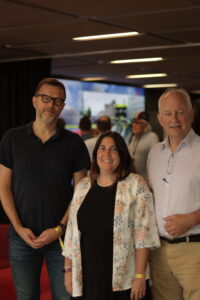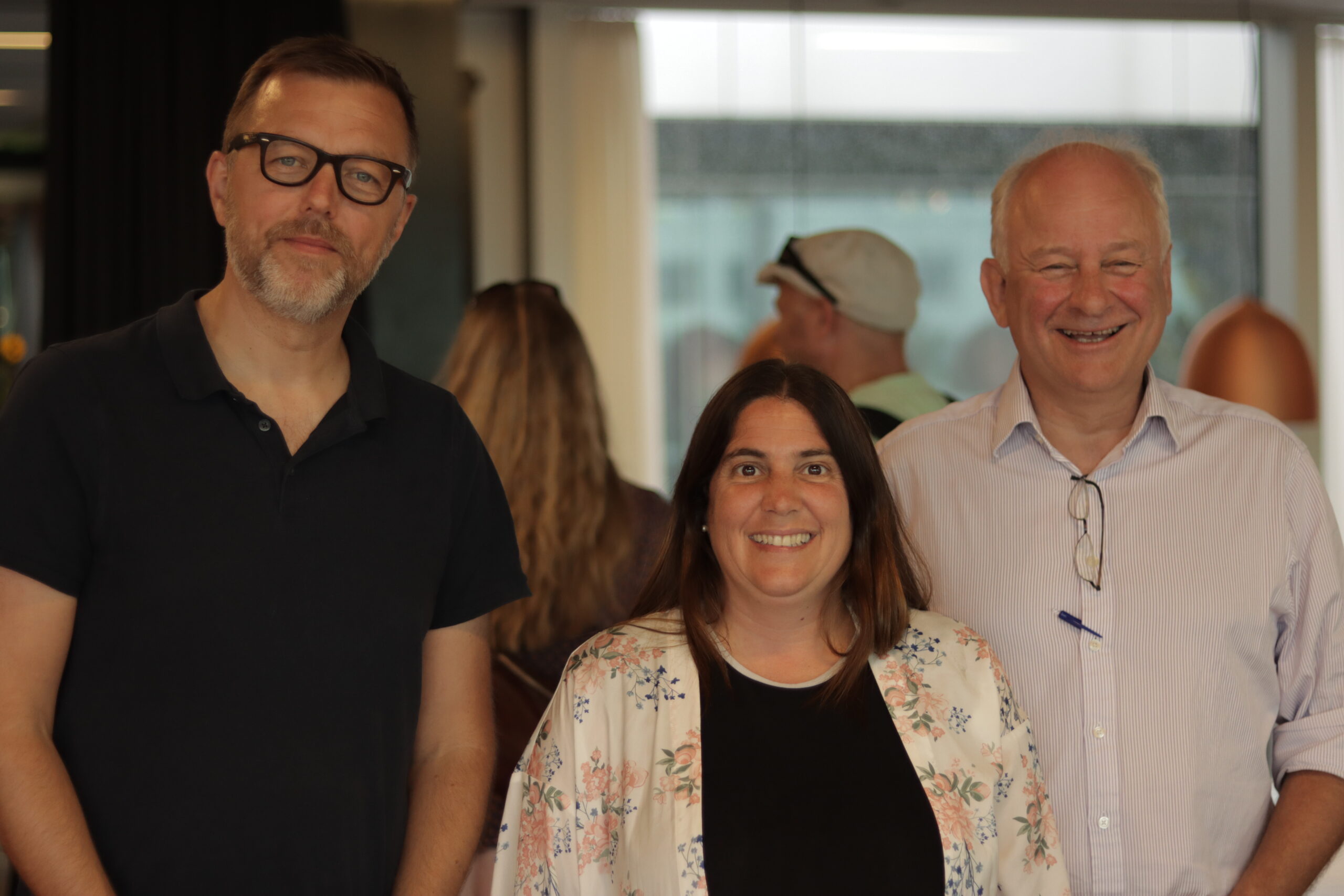Car-reliance, climate, and cultural change. These are some of the prevalent themes and challenges regarding mobility, as outlined by international experts working within the field.
As part of the Tour de France Grand Départ, BLOXHUB held a high-end mobility event together with Copenhagen Municipality. The participants at this event were experts, stakeholders, and professionals from the international mobility scene coming to inspire and network with one another.
We caught a few of them to hear about their current work on mobility, the challenges we face as an international community, and what the future of mobility will look like. Below you’ll meet Henk Swarttouw, President of the European Cycling Federation, Michiel van Kruiningen, Head of Mobility at the City of Rotterdam, and Manuela López Menéndez, Secretary of Transport & Public Works at the Buenos Aires City Government.
Challenges of Promoting Active Mobility
Coming from different places in the world and representing different approaches to mobility, the three experts also present different views on current challenges regarding mobility. Secretary of Transport & Public Works at Buenos Aires City Government,
Manuela López Menéndez highlights some of the changes that have occurred since the pandemic where people were discouraged from using public transportation if they weren’t considered essential workers:
“Fortunately, many people during the pandemic chose to walk or cycle, and we were able to increase cycling from around 4% to 10% and maintain this increase. So, during the pandemic, we decided to have new bike lanes in the avenues, which we have never done before. We did the prototype very fast, and when we saw it was working, we went to the definitive project that we have now. We have been developing more bike lanes for years and are also working on a new “shared street” design to promote active mobility,” says Manuela López Menéndez.
Active mobility is also a big part of the work on mobility in Rotterdam, but as Head of Mobility in the city, Michiel van Kruiningen, says it’s also about dealing with the political debate and telling the right story about the progress being made:
“The challenge is to facilitate the transition that is happening. You see a shift from possession to sharing, from fossil to electric. And this transition is a tough one because it brings with it a political hot debate. After all, it’s also about cars in the city. But if you tell a story about how it’s going to be more livable, greener, safer, and less hot in the summer, it’s a place not for driving through but for staying, then the potential disadvantage for fewer cars is integrated into a bigger story. So, we work a lot with these Integrated projects – not only mobility solutions, but solutions for green, livable, and safe cities,” he says and adds that it’s also a question of including citizens in the processes to make sure changes don’t feel forced.
To President of the European Cycling Federation, Henk Swarttouw, who doesn’t focus on a specific city area but all the present and future cyclists of Europe, the biggest challenge regarding mobility is lowering carbon emissions by switching away from car reliance:
“The biggest challenge is the climate and the emissions by the transport sector. The transport sector is responsible for 25% of all CO2 emissions, and three-quarters of that are from road transport – and it’s still increasing. Electrification of cars is not going to solve that, so we need a shift to other modes of transport; public transport, collective transport, active mobility, walking, cycling, shared mobility, etc.,” he says.
The Many Facets of Mobility
There has been a shift in the way we approach mobility. From it being almost entirely about technical solutions and getting people from A to B, it is now part of a larger discussion on livable cities, physical and mental health, and making greener and more climate-friendly and resilient cities. Manuela López Menéndez describes this shift through her work in Buenos Aries:
“I think cities are changing. When we began this mobility planning in Buenos Aires 12 years ago, it was mainly to have a quick response to how we get people from A to B, but then we started to see mobility as a service and as part of a livable city. We have been focusing on multiplying mobility alternatives to ensure that everyone can access the variety of possibilities offered by the city, and we do it by giving priority to public transport, cycling, and walking because they are the most efficient and sustainable means,” she says.

From left to right: Michiel van Kruiningen, Manuela López Menéndez, and Henk Swarttouw.
Henk Swarttouw also says that you cannot disregard the need to move people from A to B, but that we should also think about mobility for leisure and health:
“Mobility is of course in part for moving from A to B, getting from home to work, school, errands, shops, to the cinema, wherever you go. But we also do a lot on leisure mobility because people also move simply to move. People swim not to get across the river or the harbor, people swim because it’s fun to swim. People also cycle for their physical health and their mental health. A mobile lifestyle is good for people,” he says adding that he wants to engage more with the health sector:
“We’re so focused on climate, on mobility, on livable cities, that we forget the impact that cycling or active mobility has on the quality of life for the individual. We look too much at society, cities, and countries, but we should be looking at people and their physical and mental well-being. For that, we need to cooperate much more across silos, across levels of government, because we are working in a complex system,” says Henk Swarttouw.
To Michiel van Kruiningen mobility is never enough in itself, it is always about bigger visions about the world and cities we want to live in:
“Mobility is not an objective in itself, it’s an instrument for livable, greener cities; cities with no air pollution, cities where children are safe to play in the street. I always try to speak about this vision of mobility and try to explain that it can lead to better air quality, better green places, and safer roads. The story you tell is very important, and it can change a bit according to the political climate. With more right-dominated political parties you emphasize more safety instead of more space for bikes, and vice versa with the left-wing. The actions we do are the same, but the framing is different,” he says.
The Future of Mobility
Lastly, the experts were asked about their take on the future of mobility. Where is mobility heading in the next 5-10 years? Henk Swarttouw thinks we will see a shift around cars and car-based solutions:
“I think policymakers are going to realize that electric vehicles and autonomous vehicles aren’t going to deliver fast enough on what we need to do to reach our climate goals. It’s starting, and the pandemic has helped because it has shown that quick change is possible. Now we are still in a car-based mind frame, and I hope to see a paradigm shift in the coming years. People are going to realize that it’s not going to work if we keep our focus on cars. A hundred years ago we changed our cities from walking, horses, and cycling cities to car cities, and we can change it back,” he says.
Manuela López Menéndez also highlights car reliance as something that will change in the coming years. She emphasizes the cultural changes and mindset shifts that are needed to alter the current state of mobility:
“I think that we have a great challenge, especially in cities like Buenos Aires or countries like Argentina relating to ownership of cars. For different reasons in our society, there is still the idea that having a car is like accomplishing something. I think that in the next years, car-sharing and ownership-sharing will be very important themes. As a city, we have to work a lot on that. We need for our people to understand that it’s probably better to have a good bicycle, have good public transport, and then only be able to have a car when you want to go on vacation or a weekend trip, instead of having it all day parked in front of your house and not using it,” she says.
Michiel van Kruiningen points to the potential pitfalls of the future, but he is hopeful that it’s going in the right direction:
“I think the risk is that we only look at cities and not the rural areas. You probably still have to invest in car accessibility in places that don’t have public transport, where micro-mobility doesn’t work. Another risk about the mobility transition is that it’s only for the happy few. We can afford an e-bike, but many people can’t. In Rotterdam, we talk about inclusive mobility. Accessibility to mobility is not a right in the constitution, but maybe it should be. And the big question is how much we are prepared to pay for accessibility for everybody,” he says.
If you want to know more about our mobility event in connection with Tour de France or our international network, please reach out to Head of Global Networks, Jakob Norman-Hansen.







